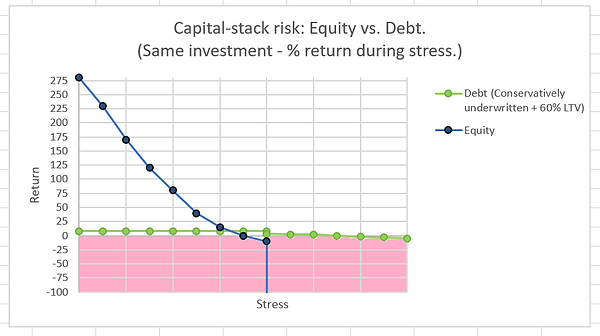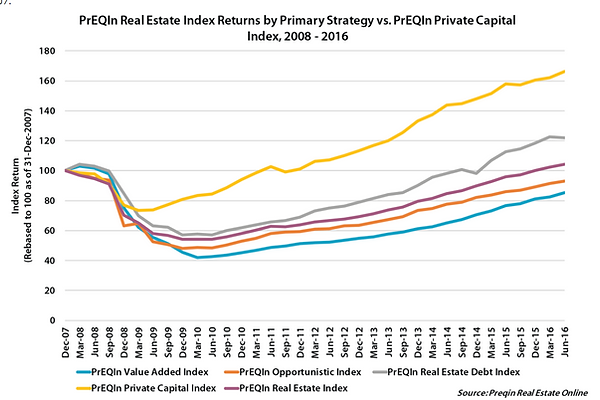Should I invest in equity or debt?
Understanding the different risk/reward profiles and the capital stack is crucial for due diligence.
January 29, 2016 BY IAN IPPOLITO

All real estate investments ultimately have to do with land and/or the structures on it. However, you can invest in real estate in two completely different ways: debt or equity.
The two have vastly different risk and return profiles, so understanding the differences (and where they fall in something called the “capital stack”) is crucial to picking the best investment for you.
Debt
When you invest in debt, you make a loan to the borrower. In return for the use of your money, they pay you back the original loan (principal) plus interest for the use of your money.
Some examples of debt investments are mortgages, bridge loans and hard money loans. The contract to repay a debt is called a promissory note; which is why some people call debt investing: “note investing”.
You can loan money for short-term (a few months to a year) or make longer term loans lasting years or decades. Payment terms might require the borrower to pay both interest and principal on every payment (like mortgages). Others (like hard money loans) are typically interest-only, meaning that the borrower pays only interest on the payments and then pays the entire principal back on the final payment when the loan comes due.
Equity
When you invest in equity, you are a part owner of the property and get to share in the profits. These profits come from rental income and/or property price appreciation.
Often equity investment returns are structured to split the profits between you and the sponsor based on certain milestones (which is called an “equity waterfall”). For example, you might invest in an apartment complex that awards you 100% of the profits up to 7% IRR. Then the investment agreement might say that you split the profit 75%/25% up to 14% IRR. And then all profit above that might be split 80%/20%.
It’s important that you understand how the split works and feel comfortable that it is protecting you as an investor and is not overly generous to the sponsor.
So what’s the difference?
In general, debt is safer than equity on that same investment. This is because if something goes wrong, and the property is foreclosed and sold, the debtholders get paid first. In a liquidation situation like this, equity holders often have no recourse. Even in situations where they do, they’re still in a much higher risk of taking losses or completely being wiped out then a debt investor in the same project.
The flip side of this is that since debt is safer it has a lower return than equity.
Also, debt investments have no upside potential, while equity does. If a real estate project is wildly successful the debt investors do not get to participate in the unexpected success and are limited to simply getting the agreed-upon interest rate. However, the equity investors do get to participate in the extra windfall.
Here's a hypothetical investment showing what the two scenarios look like. When things go well you'd much rather be in equity. When they go badly you'd much rather be invested in debt.:
Note: this doesn't mean that every debt investment is less risky than every equity investment. Investing in Bernie Madoff's debt is more risky than investing in equity in core, income-producing real estate. So you have to use judgment and look at the individual investment. However, the entire universe of debt, is safer than the entire universe of equity, so it's a useful rule of thumb:
The capital stack
All types of debt and equity are not created equal. Even in a single real estate project there are often different classes of debt and equity which have different rules for getting paid in normal times and liquidation scenarios.
The structure is called the “capital stack”. Before investing a single dollar, it’s crucial you understand the project’s capital structure and where your investment falls in that stack.
Here’s an example of a typical capital stack:
Senior debt is the safest and largest component. As the safest, it also has the lowest expected return.
Mezzanine debt is less safe because unlike ordinary debt, it doesn't have the physical property as collateral (but simply equity in the controlling company). In a default you have a much higher chance of both your return and principal being wiped out then senior debt. So it has a higher return.
Preferred equity is next and then common equity.
Not all real estate projects have the complete stack. For example, a hard money loan investment is just the senior debt portion at the base of the above and usually has no other types of debt or equity involved. Other projects might have an even more complex stack.
No matter what the structure, it’s important that you fully understand what it is in the project you are considering your investment in. Once you know that, it’s vital to understand where in the stack your particular investment would be, and what that means to the risk and reward. Once you know that, you can gauge if this investment is structured to meet your investment criteria and goals, or not.



What's your opinion?
Related articles:
Looking to learn more about investing in debt (hard money loan investing)? Here's our 4-part step-by-step series.
-
Hard Money Loan Investing Guide: Part 2 - How to protect from loss
-
Hard Money Loan Investing Guide: Part 3 - The Due Diligence Check List
-
Hard Money Loan Investing Guide: Part 4 - Top 15 hard money loan funds
-
Intermediate tutorials
About Ian Ippolito

Ian Ippolito is an investor and serial entrepreneur. He has been interviewed by the Wall Street Journal, Business Week, Forbes, TIME, Fast Company, TechCrunch, CBS News, FOX News and more.
Ian was impressed by the potential of real estate crowdfunding, but frustrated by the lack of quality site reviews and investment analysis. He created The Real Estate Crowdfunding Review to fill that gap.
In-depth information
Subscribe
-
Investing tools
